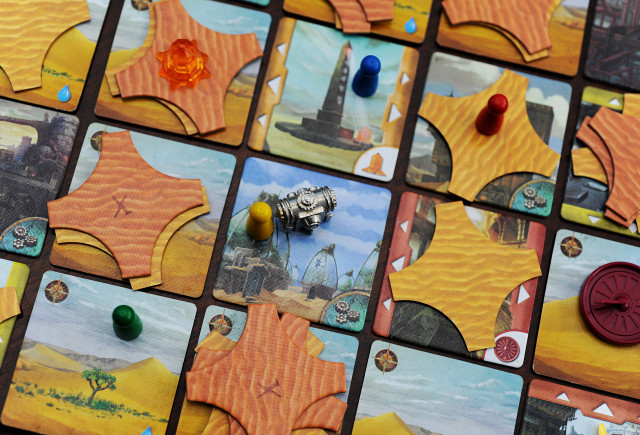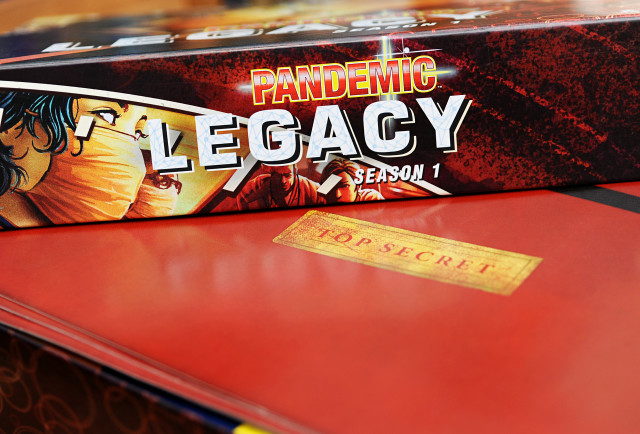We all had our childhood heroes. Some were role models, like your Mom or a local firefighter, maybe it was someone on the big screen like Tom Cruise or Reese Witherspoon. Whoever it was, we all had someone we aspired to be like as a kid, but how about as an adult? Matt Leacock is that person for me. He is one of the coolest people I can think of, hands down.
Not long after getting into the board gaming hobby, I was introduced to Forbidden Desert, my personal favourite game by ML. My experience with board games up until then had been strictly competitive. I quickly found out that there were tons more games like this one! I LOVED the idea of working together and the best part about this new discovery was that there were more cooperative games by ML specifically. Since then I’ve always had a heavy lean towards cooperative games, although I will play any and all games that present themselves.

Recently I was lucky enough to get in touch with Matt and ask him some of my burning questions, specifically related to his Forbidden series with a few others added in! Let’s check them out:
DWP: When first designing Forbidden Island, did you know then that you’d make more Forbidden games?
ML: No, I had no idea there would be follow-up games. In fact, Gamewright had never done a sequel to one of their games prior to the release of Forbidden Desert. The request that I initially got from them was for a “cooperative card game for kids”. (The design started out as a card game, then morphed into tiles ones it became clear that cards were hard to flip over on the table.) Other that that brief proposal, I really had no idea what I was getting into when I started.
DWP: Do you ever wish the Forbidden games had taken off as much as your Pandemic games have?

ML: It’s difficult to compare most games to the success of Pandemic but the Forbidden games have done extraordinarily well! I think the success of the Forbidden games may be obscured somewhat by the fact that they’re not discussed as heavily on websites such as BoardGameGeek since they’re lighter fare.
What came first; the mechanics of your games or their themes/story line?
A: I usually start with a package of story, plus core mechanisms, plus a feeling that I’d like to evoke in the players. I never sit down and think “I’d like to design a worker placement game” for example. Game mechanisms are the means to an end and don’t make a very good start for me. I have much more luck if I focus on overall experience that I’d like to create and then select story elements and mechanisms that help support that experience.
Forbidden Island started off as a card game where you and your fellow players were in hyperspace on a long-distance space voyage and were awoken suddenly after your ship drifted into an asteroid field. As asteroids hit your ship–and knocked off key modules–you race about to collect your flight plan, food for the journey, space suits, and an alien artifact. If you could make it to the escape pod with those four items, you’d win. I wanted to capture the rush of excitement as you tried to hold things together long enough to gather up everything and escape!

The story changed over time to the sinking island. But the emotions that I was chasing stayed consistent throughout development.
DWP: I’ve noticed that the Forbidden Series matched with ¾ Elemental signs. Has this been intentional? If so, does that mean we could possibly expect a Fire related Forbidden game in the near future?
ML: Glad you noticed–I’ve enjoyed playing with that aspect. We’ve got water for Forbidden Island, earth for Forbidden Desert, and air for Forbidden Sky. Who knows what the future holds…
DWP: Do you have a favourite Forbidden game or one you’re most proud of? Have they always been a more child friendly version of Pandemic for you or do you think of them as something else now?
ML: I really enjoy each of them but for different reasons. Forbidden Island is the perfect gateway game; you can give it to people who aren’t really into games in order to open them up to the world if cooperative gaming. Forbidden Desert let’s those players “level up” and also provides a lot of challenge to people that consider themselves hobby gamers. Desert is both a bit more complex (a touch harder to learn) and challenging (harder to win) than Forbidden Island. Then Forbidden Sky brings in some novel toy-like components that have attracted new players.

For me, the line appeals to a more mass-market audience with its lower complexity, artwork and story. There are many people (including my daughter!) who aren’t crazy about playing a game with disease in it and prefer the adventure story for that reason.
DWP: A lot of your games are cooperative, what about cooperative games do you enjoy the most?
ML: So many things: they’re easier to teach, there are fewer bad feelings at the end of the game, but mostly I just like the way they draw everyone together across the table in pursuit of a common goal. So many games are competitive, but so much of real life is about collaborating with others. I think it’s high time more games provide opportunities for playful problem solving where people work together, rather than against each other– especially in such divisive times as these.
DWP: When you first started thinking about becoming a board game designer, did you always know that you’d make cooperative ones?
ML: No, I had no idea that I’d be creating cooperative games at all. The first dozen or so I created were all competitive. I have come to really enjoy designing them, because of the feelings they help generate as well as the challenge of creating novel “artificial opponents” out of paper and cardboard.
DWP: Was there ever a board game that heavily influenced your interest in designing your own?

ML: I was blown away as a teenager by Avalon Hill’s Civilization by Francis Tresham. Playing that game really made me want to design games. I also enjoyed playing and making games with my uncle as a kid. He hand-crafted a steamboat game that was a real inspiration–it was the open-ended system ad he could just plug new things into it by drawing them. The whole family played it for hours one day and I was hooked.
DWP: Have there been any gaming mechanics recently that you’re really excited about ad want to see more of?
ML: I love games where you can be creative as you play. So games that include mechanisms that support being creative–be they deck-building, drawing, or constructing– usually catch my eye.
DWP: Has the board gaming community/hobby advanced in ways you expected it to over the years? Where do you see it going in the future?
ML: It’s been 19 years now since I brought my first game to Spiel to sell, and the hobby has grown more than I ever would have imagined.
One change I do expect is that the number of big titles released each year will slow gradually, possibly level off, or even decline as publishers start to focus more on quality over quantity. I expect to see them invest more in marketing the titles that are performing rather than just hoping their games will catch on in the market.
Thanks Matt, for taking the time to chat with us and talk about your career. -DWP
Comments
No comments yet! Be the first!